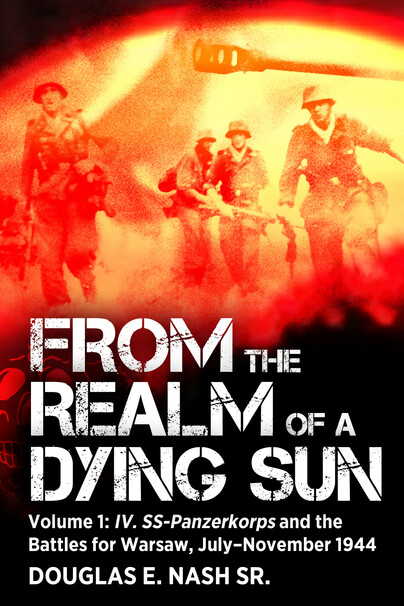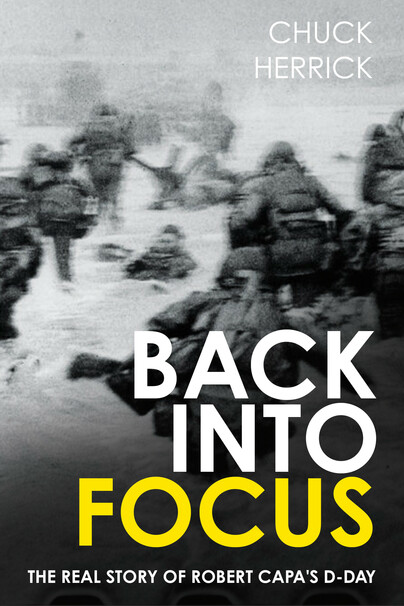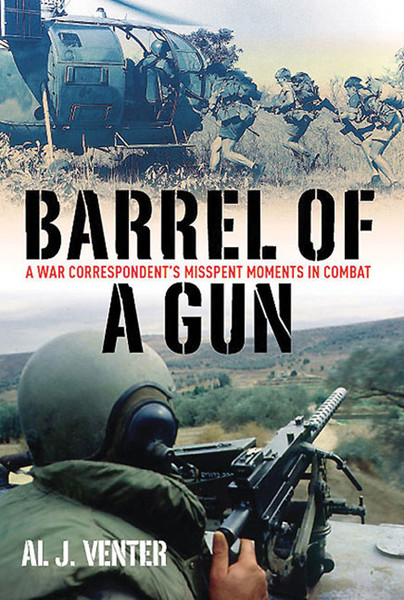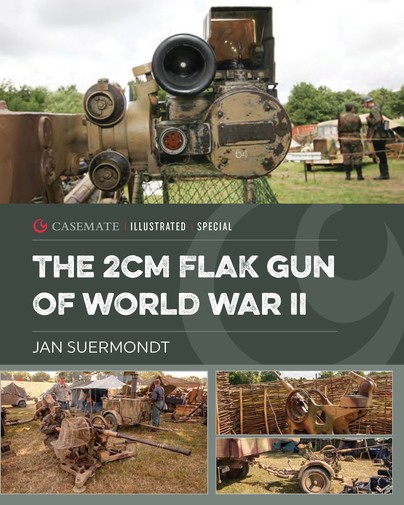Casemate Publishers is a global publisher in the fields of military history, aviation and intelligence studies, covering all aspects of military history, and all periods of conflict – from ancient civilisations to modern warfare.
Their diverse list includes military autobiographies and memoirs, histories of specific events, and a growing list of leadership titles. Casemate Publishers is also the home of the renowned Casemate Illustrated series – loved by general readers, modellers and specialists alike, these books bring visual detail to key elements of military history, from campaigns, units and battles, to aircraft, ships and weapons. Their global team is passionate about the subject and the authors and experts they work with, and in bringing readers the best of military history.

Format: Hardback
Pages: 352
ISBN: 9781636244679
Pub Date: 15 Nov 2024
Illustrations: 25 photographs
Description:
Visual Friendlies, Tally Target: Surges continues the story of the role of forward air controllers (JTACs) and Close Air Support (CAS), picking up in 2006 and continuing through 2013. This volume covers the evolution of Joint Fires through the colloquial "second phase" of the War on Terror—the "surges" of Iraq in 2007 and Afghanistan in 2010–2011. The narrative is supported by the individual accounts of US Air Force, Army, Marine close air support specialists, as well as UK, Canadian, Danish and German coalition forward air controllers.
Vol. II recounts the evolution of air power during the rising counterinsurgencies, as well as the psychology and mental makeup of these exclusive tribes. Notable accounts include the recovery mission of EXTORTION17, the first withdrawal from Iraq, previously unreported missions against insurgent strongholds, and multiple instances where the situational awareness and decision-making of forward air controllers prevented civilian casualties and fratricide.The story carries with it a continuation of the strategic lessons learned from America’s longest war: where tactical successes and innovation failed to achieve a strategic outcome amidst ambiguous grand strategy, flawed policy and a failure to understand the new battlefields of the 21st century, as recounted by the men whose air power tribes went into the breach again and again. Volume II concludes as the "War on Terror" nominally ended in 2013, as the final phase of the post-9/11 wars transitioned to the "Train, Advise, and Assist" missions in Iraq and Afghanistan.

Format: Paperback
Pages: 128
ISBN: 9781636243900
Pub Date: 15 Nov 2024
Illustrations: 100– illustrations
Description:
By the end of March 1863, Major General Ulysses S. Grant was at a crossroads in his military career. His bold attempts in the late fall 1862 and winter of 1862/63 had all come up fall short of his objective: get his army on high ground north and east of Vicksburg and capture the last major obstacle on the Mississippi River.
Grant had been stymied by the difficult region’s swampy bayous as well as Confederate resistance at key locations that thwarted his advances and prolonged his army’s miserable dispositions in the sickly camps of Louisiana bottomland. Confederate Lieutenant General John C. Pemberton had performed well using his interior rail lines and intelligence networks to place blocking forces or obstructions that delayed or derailed Grant’s movements.Realizing his career was on the line, Grant chose the riskiest operation he could have concocted. In a joint military operation, Grant marched two of his army corps down the roads and along the bayous of Louisiana, repairing them as they progressed, while Acting Rear Admiral David Dixon Porter led his ironclad gunboats with transports past the Confederate heavy artillery defending Vicksburg’s riverfront. It was Grant’s hope to get enough boats below the city to enable a crossing of the Mississippi River, a forced march into the state, and arriving at Vicksburg’s doorsteps from the east–west approach. In doing this, Grant would severe his main line of logistics and supply, something his subordinate officers thought was a disastrous mistake. Grant would take the risk in a zero-sum game: he would capture Vicksburg or destroy himself and his army doing so.This Casemate Illustrated examines the movements of the Union and Confederate armies from March 1863 through July 1863, the joint-operational cooperation between the U.S. Army and U.S. Navy, the delayed and indecisive Confederate operations to stop the Federal initiative, and how the individual soldiers conducted the one of the greatest campaigns in American military history: to control the “The Father of Waters”—the Mississippi River.

Format: Paperback
Pages: 128
ISBN: 9781636243733
Pub Date: 15 Nov 2024
Illustrations: 100-120 photographs, artworks and maps
Description:
The 14-month campaign to regain the control of Mississippi River by capturing Vicksburg, Mississippi stands as the prime example of how the Civil War would be fought and won. The Federal government’s policy of blockading the southern ports and controlling the inland waterways would only be successful with total control of the country’s largest river. Technological advances created by the war itself and used by progressive thinking Federal and Confederate commanders ensured that this vital southern supply and logistics base would be the focal point of the war on the western waters.
Ulysses S. Grant, who had risen to fame as one of the North’s prominent heroes early in the war, boldly concluded that Vicksburg would be the next nut to crack in the Federal policy for control of the Mississippi River. Understanding that only a strong relationship with US Navy could ensure the success of Vicksburg’s surrender, Grant found a man as bold and daring as himself in David Dixon Porter and his Mississippi Squadron of ironclad gunboats and fleet of vessels. These two commanders and their trusted subordinates would frustrate John C. Pemberton’s attempts to defend Mississippi and eastern Louisiana for the Confederacy. A lack of experience in commanding such an important assignment, limited resources, poor staffing, and a Confederate government consumed with the war in the east ensured Pemberton’s position would be insurmountable as the Confederacy’s tenuous hold on the Mississippi River began to fall apart.

Format: Paperback
Pages: 128
ISBN: 9781636244372
Pub Date: 15 Nov 2024
Description:
In the spring of 1945, simultaneously with the battle of the Seelow Heights, powerful Red Army spearheads participated in a three sub-offensive operations in order to clear German resistance for the Berlin operation. Between April 13 and 17, 1945, elements of the 2nd Belorussian Front replaced parts of the 1st Belorussian Front and began to prepare their offensive operations. Bitter fighting ensued, as German units desperately tried to hold their positions.
Whilst these operations continued with unabated ferocity, Zhukov’s 1st Belorussian Front broke through the final line of the Seelow Heights and nothing but broken German formations lay between them and Berlin.On April 20, Hitler's 56th birthday, Soviet artillery of the 1st Belorussian Front began shelling Berlin in preparation for attacking the city. At the same time the 1st Belorussian Front advanced towards the east and northeast of the Reich capital, whilst the 1st Ukrainian Front smashed through the last formations of the northern wing of the German Army Group Center. What followed was the Soviet Battle for Berlin. Once the 1st Belorussian Front and 1st Ukrainian Front completely encircled the city, over one million Russian soldiers began attacking into the suburbs towards the center. They faced some 45,000 soldiers in several severely depleted Wehrmacht and Waffen-SS divisions. These divisions were supplemented by the Berlin Police force, and the Hitlerjugend and Volkssturm, mainly manned by teenaged boys.

Format: Paperback
Pages: 128
ISBN: 9781636243924
Pub Date: 15 Nov 2024
Description:
A full account of the Wilderness to the James River, including Grant's rise to high command, the condition of the armies going into the critical 1864 campaign, a deep look at the commanders on both sides, and the strategy of the campaign from both perspectives. The study is combat, strategy, and tactics from the first day of action until the last, when Grant—unable to capture Richmond, but now south and east of the capital—builds a long bridge and crosses the James River to attack Petersburg. Illustrated by photographs and excellent maps, it will conclude with a note about visiting the battlefields, the casualties, the treatment of wounded, and the burial of the dead.

Format: Hardback
Pages: 232
ISBN: 9781636244952
Pub Date: 15 Nov 2024
Illustrations: 40 photographs
Description:
Raised on a farm in Montana, Vernon Drake enlisted in the Army Air Corp in the spring of 1942. Assigned to the 493rd Bomb Squadron, 7th Bomb Group of the 10th Air Force stationed in India, he piloted B-24 bombers into Burma in a fight to prevent the Japanese from advancing north to China, then flew C-108 gas-hauling tankers across the formidable Himalayas to support the U.S.
and Allied armies. This dangerous airlift saw tons of fuel and supplies flown daily over the tallest mountain range in the world, regardless of the weather.He and the other airmen—aged only eighteen to twenty-five—flew dangerous missions over unforgiving territory against a brutal enemy. To provide some personal identity in an impersonal war, aircrews often painted artwork and identifying names onto the nose of their aircraft. As a talented artist, Lt Drake would spend many off-duty hours painting aircraft at the request of their crews, becoming a significant contributor to the nose art of the 10th Air Force.Drake’s story, pieced together from his meticulous records, contrasts the hours spent creating works of art with the moments of sheer terror in combat over enemy targets and navigating through towering mountains engulfed in murderous storms while carrying thousands of gallons of highly explosive fuel.

Format: Paperback
Pages: 128
ISBN: 9781636244600
Pub Date: 15 Nov 2024
Illustrations: 150 photos
Description:
A fully illustrated introduction to the role, and experience, of the Panzer crewman.The German Panzerwaffe ripped up the rulebooks of war that had been laid down by the grinding slaughter of the trenches of World War I. Armored vehicles, close-air support, and bold leadership based on mission command, Auftragstaktik, cut a deadly swathe through the armies of east and west Europe.
The Panzers made a significant contribution to Nazi successes; they remained steadfast in defense as their conquests slipped away their grasp from the apogee at Stalingrad and El Alamein in late 1942, through the long years of retreat to final defeat. Attrition and overwhelming odds blunted the opportunities for advances, but with increasingly powerful weaponry, the Panzerwaffe stiffened the German defensive backbone right to the end.Part of the reason for these successes was undoubtedly the Panzers themselves, but it wasn’t just the weapons that led to the Panzers’ successes—it was the way they were handled. A weapon is only as good as those who use it and the Panzertruppen—from higher command down to individual crew members—proved themselves to be very good at using their weapons. Not just the men who fought in the tanks but those who maintained them and kept them in the field, recovered and rebuilt the casualties, and dealt with the over-complexity of design and the huge variety of types of tank, weapon and ammunition. Selection and training standards—so good in the early war years—may have dropped off as wartime exigencies bit deep, but from 1939 to 1945 German Panzer crew were second to none. This Casemate Illustrated provides a full introduction to the role, and experience, of the Panzer crewman.

Format: Hardback
Pages: 320
ISBN: 9781636244983
Pub Date: 15 Nov 2024
Illustrations: 20-40 photographs
Description:
The inspiring life story of a young boy stricken with polio who, through sheer grit, the drive to achieve, and love of the military, overcomes childhood paralysis, takes up the physical challenges of an infantry career and joins the elite airborne forces. Bill Matz earns his Ranger Tab and Master Parachute Badge, and rises to the highest levels of achievement in the U.S.
Army. He serves in the DMZ in Korea, leads troops in combat in Vietnam, is wounded in the Tet Offensive, receives the Distinguished Service Cross for Valor, and leads troops again during the Panama invasion—all while wearing a specially fitted combat boot and a foot orthotic device on his atrophied “polio leg.” Later duties include serving as Executive Secretary to the Secretary of Defense during the Reagan years.Retiring as a Major General in 1995 after numerous overseas deployments and an illustrious 30-year Army career, he works in the administrations of Presidents George W. Bush, Barack Obama and Donald Trump. Keeping veterans’ causes close to heart, he leads the fight on behalf of the wounded, disabled and their families as a member of the Veterans Disability Benefits Commission and as President of the National Association for Uniformed Services, and becomes the guardian of America’s war dead as Secretary of the American Battle Monuments Commission.A witness to or participant in many of the most defining moments of American history of the last sixty years, Bill Matz retired “for the fifth time” in 2021 and remains active as a recognized public speaker and proponent for veterans and the military. My Toughest Battle portrays the personal challenges and inner resources he relied on to meet the demands of service to his nation as an infantryman and paratrooper in times of peace and war, and candidly reveals how he was able to achieve his goals while battling the debilitating effects of polio.

Format: Hardback
Pages: 304
ISBN: 9781636244921
Pub Date: 15 Nov 2024
Illustrations: 2030 photographs
Description:
In 2006, the shock and awe campaign of securing the major cities had ended, and the Iraq War had moved into an alien phase for the clandestine operators of Blackflag1. Their motto "swift, silent, deadly," the Marine operators of 2nd Reconnaissance Battalion were not intended for conventional warfare but they were now tasked with holding the Zaidon region of Iraq. In this deadly zone, where even Saddam would not send his most elite troops, the operators were faced with the war on a new front; fierce local tribes who proclaimed they would kill any who entered their lands, foreign insurgents or Marines alike.

Format: Paperback
Pages: 541
ISBN: 9781636244877
Pub Date: 31 Oct 2024
Illustrations: maps and 24pp black and white photos
Description:
A detailed account of Herbert Otto Gille’s IV SS-Panzerkorps that participated in many of the key battles fought on the Eastern Front during the last year of WWII.During World War Two, the armed or Waffen-SS branch of the Third Reich’s dreaded security service expanded from two divisions in 1940 to 38 divisions by the end of the war, eventually growing to a force of over 900,000 men until Germany’s defeat in May 1945. Not satisfied with allowing his nascent force to be commanded in combat by army headquarters of the Wehrmacht, Heinrich Himmler, chief of the SS, began to create his own SS corps and army headquarters beginning with the SS-Panzerkorps in July 1942.
As the number of Waffen-SS divisions increased, so did the number of corps headquarters, with 18 corps and two armies being planned or activated by the war’s end.The histories of the first three SS corps are well known – the actions of I, II, and III (Germanic) SS-Panzerkorps and their subordinate divisions, including the Leibstandarte SS Adolf Hitler, Das Reich, Hitlerjugend, Hohenstaufen, Frundsberg and Nordland divisions, have been thoroughly documented and publicized. Overlooked in this pantheon is another SS corps that never fought in the west or in Berlin but one that participated in many of the key battles fought on the Eastern Front during the last year of the war – the IV SS-Panzerkorps. Activated during the initial stages of the defense of Warsaw in late July 1944, the corps, consisting of both the 3. and 5. SS-Panzer Divisions (Totenkopf and Wiking, respectively) was born in battle and spent the last ten months of the war in combat, figuring prominently in the battles of Warsaw, the attempted Relief of Budapest, Operation Spring Awakening, the defense of Vienna, and the withdrawal into Austria where it finally surrendered to U.S. forces in May 1945.Herbert Otto Gille’s IV SS-Panzerkorps was renowned for its tenacity, high morale and, above all, its lethality, whether conducting a hard-hitting counterattack or a stubborn defense in situations where its divisions were hopelessly outnumbered. Often embroiled in heated disputes with its immediate Wehrmacht higher headquarters over his seemingly cavalier conduct of operations, Gille’s corps remained to the bitter end one of the Third Reich’s most reliable and formidable field formations.

Format: Hardback
Pages: 384
ISBN: 9781636244730
Pub Date: 17 Oct 2024
Illustrations: 82 photos, charts, drawings
Description:
Although Capa's Falling Soldier image from the Spanish Civil War has been definitively proven to be a staged propaganda fake, no one has applied a similarly critical eye to his later work. This book is the first effort to establish the facts behind the fables surrounding his D-Day adventures and the images he produced during that period. This book examines the fictionalized account Robert Capa penned in his pseudo biography Slightly Out of Focus.
Written in the hopes of it becoming a movie, Capa included many elements which were exaggerated or simply not true, while omitting many relevant events. As he himself said in the dust jacket for that book: “Writing the truth being obviously so difficult, I have in the interests of it allowed myself to go sometimes slightly beyond and slightly this side of it. All events and persons in the book are accidental and have something to do with the truth.”This new account carefully details the actual events surrounding Capa's D-Day adventures, using official SHAEF files, still and motion picture images taken by other cameramen who were near or with Capa, and a variety of accounts of witnesses. It examines several aspects of Capa's narrative and reveals the truth behind the fiction: he claimed that he landed in the First Wave with Company E, in reality he landed almost two hours later in Wave 13 with the regimental commander. Analysis reveals how many of his images were presented in a false context and as a result have been misinterpreted for decades. Building on Allan Colleman and his team's proof that the bulk of Capa D-Day photos could not possibly have been ruined in a darkroom accident, this gripping expose details the effects the FORTITUDE deception plans had on censorship, and how the censorship system would have retained the images popularly thought to have been lost.

Format: Hardback
Pages: 304
ISBN: 9781636244853
Pub Date: 15 Oct 2024
Description:
An examination of the panorama of individuals whose leadership helped make the Patriot cause successful in South Carolina. Historians Kevin Dougherty and Steven D. Smith look beyond the towering figure of Francis Marion to profile significant personalities and actions both on and off the battlefield in this innovative approach to the Revolutionary War in South Carolina.
The book profiles a range of individuals: Henry Laurens was the President of the Council of Safety. Richard Furman was the pastor of a church; John Rutledge was the Governor of South Carolina; and Rebecca Motte was a plantation owner. William Moultrie and Andrew Pickens—perhaps most familiar as soldiers—are discussed in their noncombatant roles: Moultrie as a prisoner of war and Pickens as a postwar civic leader. Military leaders William Jasper, Thomas Sumter, Francis Marion, Isaac Shelby, Nathanael Greene, Daniel Morgan, Tadeusz Kosciuszko, Hezekiah Maham, and Henry Lee round out the selection of profiles.The profiles are preceded by a historical overview of the Southern Campaign and the Revolutionary War in South Carolina, in order to provide the reader the background necessary to understand the leadership profiles in context. The book’s conclusion highlights that the Revolutionary War was a landmark in the “democratization” of war and that the choices made by these leaders and their followers reflect the same element of choice inherent in the democratic process.

Format: Hardback
Pages: 505
ISBN: 9781935149255
Pub Date: 06 Oct 2024
Description:
Anybody who says that the pen is mightier than the sword hasn't spent time in Somalia, or in Beirut during its bloody heyday. So begins this fascinating memoir of a journalist, filmmaker, and just plain raconteur who has made a career of examining warfare-on the ground as the bullets are flying. While the average citizen is aware of violent conflicts broiling all around the globe, Al J.
Venter has felt the need to see them all in person, preferably at the centre of the action. Born in South Africa, Venter has found no shortage of horrific battles on his own continent, from Rhodesia to Biafra, and Angola to Somalia. He has ridden with the legendary mercenary group Executive Outcomes, flown with the Selous Scouts on their bounty hunts,' and traipsed the jungles with both guerrillas and national troops under whoever in the country then held power. During Sierra Leone's civil war he flew in the government's lone Mi-24 Hind gunship as it blasted apart rebel villages and convoys. In the Middle-east he went into southern Lebanon with the invading Israeli army, and at one point was held prisoner by Hezbollah. In his journeys, Venter associated with an array of similarly daring soldiers and journalists, from Mad MikeA" Hoare to Danny Pearl, as well as elite soldiers from around the world, many of whom, he sadly relates, never emerged from the war zones they entered. Al Venter here offers the reader his own personal combat experiences, in all their multifaceted fascination.

Format: Hardback
Pages: 160
ISBN: 9781636243375
Pub Date: 30 Sep 2024
Series: Casemate Illustrated Special
Illustrations: 200 photographs and diagrams
Description:
The highly successful 2cm FlaK 30 series of guns used by Germany in World War II was developed from the Solothurn ST-5, a 20mm anti-aircraft gun designed by Solothurn in Switzerland, itself an enlarged Solothurn MG30. Solothurn was owned by the German firm Rheinmetall, which along with all other German manufacturers was prohibited from developing certain weapons under the terms of the Versailles Treaty. The partnership with Solothurn was a common way to circumvent restrictions.
The ST-5 fired the “Long Solothurn” ammunition – the most powerful 20 mm round available.Heavily illustrated, this title discusses the development of the famous 2cm FlaK 38 together with its predecessor, the 2cm FlaK 30, and also the lightweight 2cm Gebergs FlaK 38 and the 2cm Flak vierling. It discusses the uses of the gun in World War II, and its various mounts on both trucks and tank chassis. By the end of the war over 17,500 of these guns were in service.

Format: Hardback
Pages: 288
ISBN: 9781636244716
Pub Date: 29 Sep 2024
Illustrations: ~50 photographs
Description:
“The Devil’s Playground” was anything south of the second canal to the men of Charlie Company’s 2nd Platoon—Two Charlie—during their 2009–2010 deployment to the Arghandab River Valley in Afghanistan. The valley had been a notorious hot spot throughout history, with the Russians unable to maintain a foothold in the 80s and Coalition forces now facing the same problem during Operation Enduring Freedom.The Two Charlie paratroopers deployed as part of the 2-508th PIR, Two Fury, of the 82nd Airborne Division, but always seemed to be on their own.
They started their deployment attached to Canadian forces in Panjwai but were shortly moved into the Arghandab with one of the battalion’s biggest Areas of Operation. They inherited a bare bones outpost that they worked hard to turn into the defendable position known as COP Tynes, while patrolling the grape fields and orchards of the valley. Little did they know that when the leaves returned to the valley in the spring, so too would the fighting.As the fighting picked up in the valley, the men of Two Charlie continued to sustain casualties as they fought day in and day out. There was never a dull moment in the Arghandab, and the fact that Two Charlie had to patrol, act as a quick reaction force, and secure their outpost on their own ensured that they never stopped. The men were constantly brought to their breaking point as their numbers dwindled and the fighting intensified. The men all started to believe that they weren’t going to make it out of the valley alive. The one rule of the valley would be proved time and time again: in the end, the valley always wins.This book shares the story of the men of Two Charlie and their fight for survival in the Arghandab River Valley, the Devil’s Playground.

Format: Hardback
Pages: 256
ISBN: 9781636244228
Pub Date: 24 Sep 2024
Description:
With a new century and a new enemy came a new kind of war: low intensity and civilian-dominated, blending austere rural and dense urban environments alike. Into this new kind of war, the American military launched two invasions against terrorist networks and military rivals, relying on airpower—close air support (CAS)—at a scale never before seen in combat.The Global War on Terror was the “CAS war.
” Forward Air Controllers were on the front lines from the very first moments of the war, directing airstrikes against enemies in their safe havens, safeguarding friendly forces and civilians alike to their utmost, and achieving unprecedented success with limited resources. This volume captures the heroic accounts of the first Tactical Air Control Party (TACPs) in Afghanistan and Iraq, and how Close Air Support fundamentally reshaped the American war machine in the first five years of the War on Terror.


















